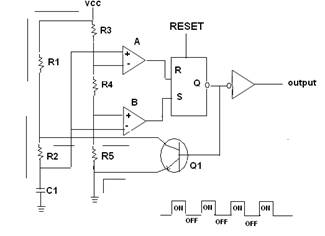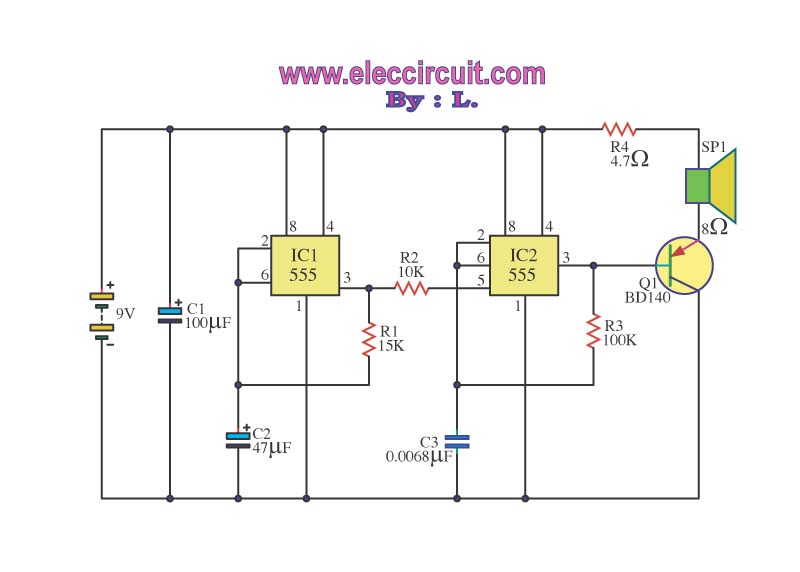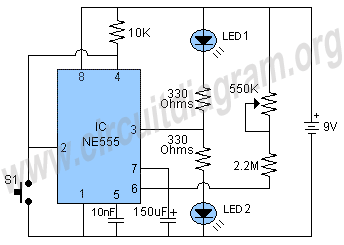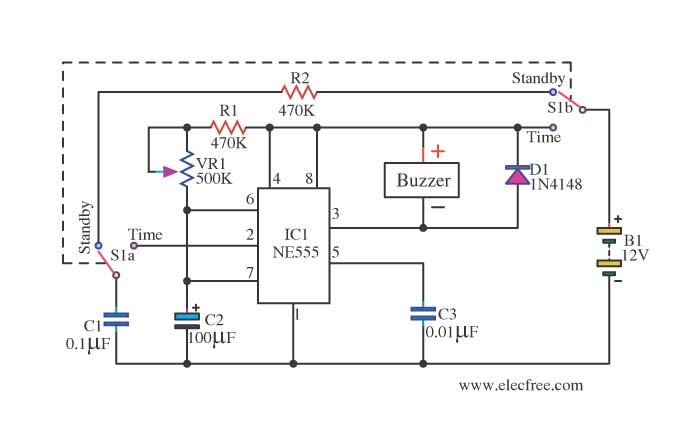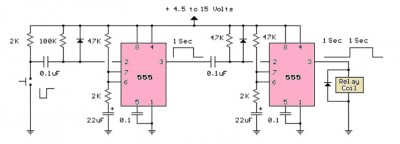
555 Monostable Multivibrator
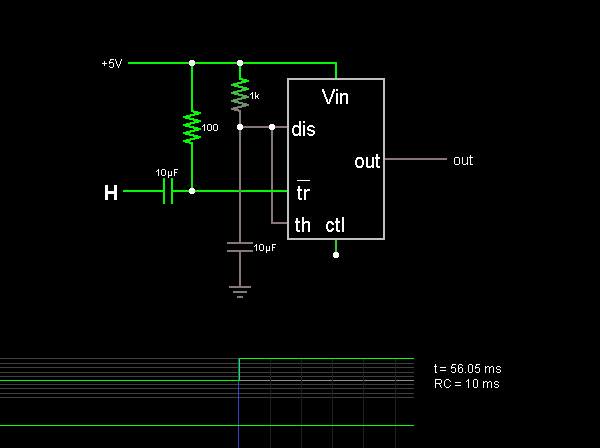
This circuit is a monostable multivibrator, or one-shot, made with a 555 timer chip. Clicking the logic input on the left ("H") causes the output to go high for a short duration before returning to low. A timing interval initiates when the trigger input ("tr") is brought low. When this occurs, the 555 output goes high, which charges the capacitor until it reaches 6.67V. After this timing interval concludes, the output goes low, and the capacitor discharges through the "dis" input. The capacitor connected to the trigger input makes the monostable negative-edge triggered. If the capacitor is replaced with a wire and the logic input is held low for an extended period, the 555's output will begin to oscillate.
The described circuit utilizes the 555 timer in its monostable configuration, which is commonly employed in applications requiring a single pulse output in response to a trigger signal. The circuit operates by leveraging the internal comparators and flip-flop of the 555 timer. When the trigger input ("tr") is pulled low, it activates the timer, causing the output pin to transition high. This high state remains for a duration determined by the resistor-capacitor (RC) time constant, which is calculated using the formula:
\[ T = 1.1 \times R \times C \]
where \( T \) is the time the output stays high, \( R \) is the resistance connected to the discharge pin, and \( C \) is the capacitance connected to the threshold and trigger pins.
In this configuration, a capacitor is used to control the timing interval. As the output goes high, the capacitor charges through the resistor until it reaches the threshold voltage, at which point the output goes low, and the capacitor discharges through the discharge pin. The choice of capacitor value and resistor can be adjusted to achieve the desired timing interval.
The negative-edge triggering characteristic of the monostable multivibrator is essential for applications where a pulse is needed in response to a falling edge of the input signal. If the capacitor is replaced with a direct connection to ground, the circuit will respond differently; holding the input low for an extended time can cause the output to oscillate due to the rapid charging and discharging of the capacitor, indicating a shift from a stable one-shot operation to an unstable oscillatory state.
This circuit is widely used in timer applications, pulse-width modulation, and as a delay mechanism in various electronic systems, showcasing the versatility and functionality of the 555 timer in practical electronic designs.This circuit is a monostable multivibrator, or one-shot, made with a 555 timer chip. Click the logic input on the left (the "H"), and the output goes high for a short time, and then it goes low again. A timing interval starts when the trigger input ("tr") is brought low. When this happens, the 555 output goes high. This causes the capacitor to be charged until it reaches 6. 67V. Then, the timing interval ends, the output goes low, and the capacitor is discharged through the "dis" input. The capacitor in front of the trigger input causes the monostable to be negative-edge triggered. If the capacitor is replaced with a wire, and the logic input is held low too long, then the 555`s output will start to oscillate.
🔗 External reference
The described circuit utilizes the 555 timer in its monostable configuration, which is commonly employed in applications requiring a single pulse output in response to a trigger signal. The circuit operates by leveraging the internal comparators and flip-flop of the 555 timer. When the trigger input ("tr") is pulled low, it activates the timer, causing the output pin to transition high. This high state remains for a duration determined by the resistor-capacitor (RC) time constant, which is calculated using the formula:
\[ T = 1.1 \times R \times C \]
where \( T \) is the time the output stays high, \( R \) is the resistance connected to the discharge pin, and \( C \) is the capacitance connected to the threshold and trigger pins.
In this configuration, a capacitor is used to control the timing interval. As the output goes high, the capacitor charges through the resistor until it reaches the threshold voltage, at which point the output goes low, and the capacitor discharges through the discharge pin. The choice of capacitor value and resistor can be adjusted to achieve the desired timing interval.
The negative-edge triggering characteristic of the monostable multivibrator is essential for applications where a pulse is needed in response to a falling edge of the input signal. If the capacitor is replaced with a direct connection to ground, the circuit will respond differently; holding the input low for an extended time can cause the output to oscillate due to the rapid charging and discharging of the capacitor, indicating a shift from a stable one-shot operation to an unstable oscillatory state.
This circuit is widely used in timer applications, pulse-width modulation, and as a delay mechanism in various electronic systems, showcasing the versatility and functionality of the 555 timer in practical electronic designs.This circuit is a monostable multivibrator, or one-shot, made with a 555 timer chip. Click the logic input on the left (the "H"), and the output goes high for a short time, and then it goes low again. A timing interval starts when the trigger input ("tr") is brought low. When this happens, the 555 output goes high. This causes the capacitor to be charged until it reaches 6. 67V. Then, the timing interval ends, the output goes low, and the capacitor is discharged through the "dis" input. The capacitor in front of the trigger input causes the monostable to be negative-edge triggered. If the capacitor is replaced with a wire, and the logic input is held low too long, then the 555`s output will start to oscillate.
🔗 External reference
